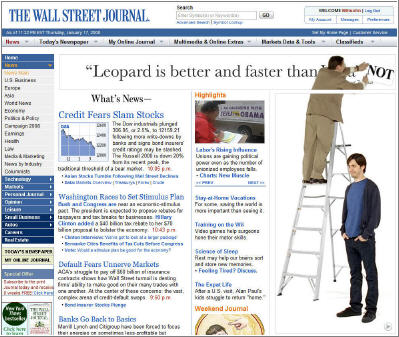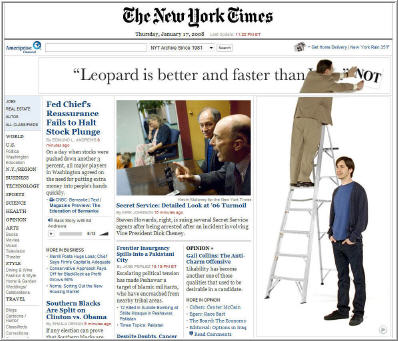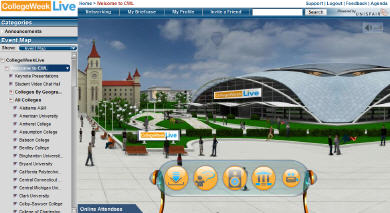-
"Mac vs. PC" Roadblocks on WSJ & NYT
Ending the week on a slightly lighter note, if you happened to go to WSJ.com or NYT.com yesterday, you would have seen that Apple bought out all the top of page ad inventory at both sites for its latest "Get a Mac" video spot (also known as the "Mac vs. PC" ads), which have been hugely popular on TV and online.


Apple's so-called "roadblock" strategy yesterday meant that every single visitor to these 2 sites were exposed to the same leaderboard/skyscraper video ad highlighting WSJ writer Walt Mossberg's opinion that Apple's latest Leopard OS release is "better and faster than Vista." Apple has a whole gallery of its "Get a Mac" ads here, though this new one is not yet posted.
In the online ad business, this type of video ad is referred to as "rich media." I haven't spent much time in VideoNuze discussing rich media ads, instead concentrating on pre-rolls and overlays ads which are actually adjacent to video content. Rich media ads show that there are many different ways to leverage video's emotional and informational impact even when there is no underlying video content to be adjacent to. Given the limitation of high-quality video content against which to run video ads, rich media has become an important and growing segment of the overall online ad business.
While, some rich media ads are way too "in your face" and spoil the user's experience, I think the way the yesterday's roadblock was executed is well within bounds. The video begins playing when the site loads, but the audio is muted. The user has to click the audio icon, and then the spot replays from the start. This means there's been an opt-in decision, which leads to higher engagement. Also, unlike many other rich media spots, the ad is composed solely of a leaderboard and skyscraper, so it doesn't have any obnoxious "pop-ups", "floating" or "expandable" components that block the underlying site content. These are the types of things that drive users crazy.
Rich media ads are an important part of the mix for fully understanding what's happening with video online, especially for advertisers who want to explore all options for leveraging video's emotional impact. I see the category continuing to grow. If ads are well-executed like Apple's, there will not only be minimal user pushback, but rather genuine opportunities for branding and interactivity.
Categories: Advertising
Topics: Apple
-
PlatformQ Taps Broadband Video for Virtual Events
While it's easy to fixate on how broadband video delivery is opening up new distribution opportunities for films and TV programming, there is also a ton of innovation happening well outside the professional video space.
I'm always keen to learn about entrepreneurs who are recognizing that broadband video can have a revolutionizing influence on sectors in which they're deeply familiar. A recent example to hit my radar is PlatformQ, which is harnessing broadband to create powerful virtual events in the higher education, energy and health care sectors.

PlatformQ sees itself as a digital media company in the sense that revenues will be derived from sponsorships; another way of thinking about them is as a next-generation, broadband-powered trade show company. I recently caught up with Robert Rosenbloom, CEO/Co-Founder (former VP Biz Dev/Co-Founder of iCongo) and Chris Charron, VP Product Management (former Group VP at Forrester Research) to learn more.
PlatformQ's first event, CollegeWeek Live, was held in November '07 and drew 15,000+ registrations and 100+ participating colleges. More than an aggregation of text/graphic info, CWL featured live, streamed keynotes from 8 admissions experts (originating from studios around the U.S.), 50 hours of live video chat sessions between actual students and prospective applicants, and thousands of hours of chat sessions. For this event, PlatformQ used Unisfair as the key underlying events technology, but it believes there a number of other alternatives for future shows depending on specific requirements.

The key to CWL is that it creates an informative and intimate user experience using broadband video to augment the traditional college search process. It's not just a win for prospective applicants. Bringing this appealing audience together is a magnet for all kinds of marketers, and thus CWL creates tons of sponsorship opportunities, many of which can be video-based as well.
In addition, all user behavior in CWL is tracked, so it is a great lead-gen source for the participating colleges and an opportunity for them to shoot their own video to showcase their school in new and innovative ways. Since CWL will be held at least semi-annually, schools can showcase timely events (e.g. football victories, winter scenes, etc.). Taken together, CWL opens up a whole new window for applicants into the overwhelming college selection process by using technologies (video, chat, social networking, etc.) that are already very familiar to them.
Next up for PlatformQ are virtual events in the energy and health care sectors, which the company believes are ripe for broadband video to also add new value. This seems like a great business model to me as it delivers strong value to all the target constituencies. It is also another terrific example of how broadband is stimulating new innovation in areas that traditionally had little or nothing to do with video. PlatformQ is based in Needham, MA and has done one angel round.
Categories: Startups
Topics: PlatformQ
-
Apple TV Improves, Vudu is In its Crosshairs
As widely expected, yesterday Apple launched movie rentals in iTunes, with titles from all the major studios. Steve Jobs also announced price cuts and a number of key enhancements to Apple TV, squarely repositioning the device as a "broadband movies appliance" (my term). Apple TV now allows direct ordering (no computer needed) and a much improved UI prominently featuring movies. The message from Apple is
 clear: the primary value proposition for Apple TV's prospective buyers is convenient movie rentals through iTunes.
clear: the primary value proposition for Apple TV's prospective buyers is convenient movie rentals through iTunes. In the last few weeks there has been much buzzing about which companies might feel the most competitive pressure from Apple's launch of movie rentals. Here's how I see it: when rentals are combined with Apple TV's new features, the company that has to be waking up this morning most nervous about Apple's news yesterday is Vudu, because it has the most obviously similar value proposition.
Some of you may not be familiar with Vudu. It is a recently launched combination online movie/TV on demand service and companion box that has gained a lot of favorable early reviews. The company is backed by Benchmark and Greylock, two huge and highly regarded venture firms. While any startup faces long odds of success, with Vudu now going up against the Apple branding and marketing juggernaut, Vudu's odds
 seem even more daunting. In fact, one wonders how the folks at Benchmark and Greylock, when considering their original Vudu investment, weighed the very question of Apple's entry into this market, as it was somewhat inevitable.
seem even more daunting. In fact, one wonders how the folks at Benchmark and Greylock, when considering their original Vudu investment, weighed the very question of Apple's entry into this market, as it was somewhat inevitable.To step back for a moment, as many of you know, I'm skeptical about all appliances meant to bridge the broadband and TV worlds, as I think they have only narrow consumer appeal and create new inconveniences. Apple TV and Vudu are even more specifically-directed at people who are focused on premium movie and TV content, not gaining access to the wider world of broadband video (note Apple TV does provide some access to YouTube videos and podcasts). In effect, purchasers of either of these products value the instant viewing gratification they offer more than the selection, portability, unlimited viewing windows and "extras" that DVDs provide. And of course there are a broad array of choices and models for accessing DVDs (e.g. Netflix, Blockbuster, Wal-Mart, etc.).
However, for interested buyers, my sense is that both Apple TV and Vudu do an admirable job at delivering online movies and TV programs. The issue is that, if I was considering a purchase, and was obviously only going to buy one, I'd be hard-pressed to see why I'd pick Vudu over Apple TV. Consider: Apple TV is cheaper ($329 vs $399 for Vudu, albeit with smaller storage space), provides access to your music library and podcasts already configured in iTunes, allows easy display of your photos, has a familiar iPod/iTunes UI and enables transfers to these devices for portable viewing. Apple TV is also backed by a strong and well-known brand, giving additional comfort that the company will be around for a long time to come, which is always a nagging question when buying anything from a startup.
The whole category of broadband movie appliances is going to remain pretty small until the key limitations are resolved (small selection, 24 hour playback, 30-day expiration, no portability, no "extras", etc.). When these are fully addressed, online delivery of movies and TV programs will happen in a big way, no question.
So for now, given these limitations, what we're really seeing is a skirmish for positioning and branding, with an eye toward the long-term win. This dynamic in particular gives Apple, as a multi-billion dollar diversified company, yet another a big advantage over a single product startup. I've learned never to count out plucky startups, but given Apple TV's new positioning plus rentals, the mountain Vudu is trying to climb just got a whole lot more treacherous.
What do you think? Post a comment and let everyone know!
Categories: Aggregators, Devices, FIlms
Topics: Apple, Apple TV, iTunes, VUDU
-
Nexidia Brings Phonetics to Video Search Space
Innovation in the video search space just keeps on coming. The latest is from a company named Nexidia, which already operates in other verticals and is now targeting the media space as well. I caught up with Drew Lanham, SVP of Media for an update on their approach and how it differs from others in the market today.
Nexidia creates a searchable phonetic representation of the audio track, which it calls a "Phonetic Audio Track" or PAT file. These PAT files are then indexed, and queries are matched against them. The company believes the advantages of phonetics over traditional speech-to-text and metadata-based approaches are better accuracy (particularly against unrecognized phrases), faster indexing and lower-cost scaling. For example, Drew said that an hour of video can be indexed automatically by Nexidia in 15 seconds, while he believes that speech-to-text would be a 1:1 relationship, so an hour to index an hour of video.
Obviously there are real speed-to-market opportunities for content providers, so this would be a solid competitive advantage. Nexidia owns its own phonetics technology, which gives it flexibility in further developing it to meet customers' specific needs. Drew said metadata is also used to augment the phonetics-based approach.
Nexidia search results are the full long-form segment containing the search phrase, not just clips. Hash marks denote where the search term is spoken. This approach means that content providers no longer have to worry about creating and managing clips, thereby reducing their costs. It also means users get the full context of the program, if desired.
The company already has substantial operations in homeland security, call centers, legal and enterprise search, and has recently begun targeting the media vertical. One live example can be found at http://www.11alive.com/, which is the web site of WXIA in Atlanta. I played around with it a bit and found the results to be impressive, though I thought the interface needed some improvements. Drew showed me the next generation interface, which is stronger and offers new features like clipping, exploring tag-related content and syndication.

Drew said the company is getting a lot of traction in the media editing space (Avid, etc.), and is re-starting discussion with the top 20-30 media properties. It envisions being an "ingredient brand" and not having a consumer-facing portal. Nexidia again shows that content providers are going to be able mine lots of new value from their video archives. These troves of video are also going to yield unprecedented new targeted advertising opportunities.
Categories: Video Search
Topics: 11Alive.com, Nexidia
-
Netflix-Apple Battle is Illusory
Netflix announced this morning that it was removing the usage cap on its "Instant Watching" feature for unlimited plan subscribers. This feature allows subscribers to choose from 6,000 titles (and growing) to stream and view on their PCs. Up until now subscribers received an allocation of streaming hours based on their monthly subscription level (e.g. 17 hours if subscribing at $17/mo). Now the hours will be unlimited. It's a smart move for Netflix and a great value proposition for Netflix subscribers.

AP first reported the change yesterday and is depicting it as a preemptive move against Apple, which is anticipated to announce tomorrow that movie rental downloads will be available in iTunes. The price point is expected to be $3.99/download. This is a major departure for Apple's iTunes, which has, of course, stuck religiously to its purchase download model for both music and videos.
Others have also depicted Apple's move as a direct strike at Netflix, but I think this battle is illusory. Rather, I view Apple's introduction of rentals as clear competition for the likes of Movielink, CinemaNow, Amazon
 Unbox, XBox LIVE and other rental stores, but not a blow to Netflix. The value propositions are very different. That's because Netflix very wisely has made the Instant Watching feature a value add for its subscribers, not an incremental fee.
Unbox, XBox LIVE and other rental stores, but not a blow to Netflix. The value propositions are very different. That's because Netflix very wisely has made the Instant Watching feature a value add for its subscribers, not an incremental fee. As a $16.99/mo subscriber myself, I love the fact that Netflix is unmetering Instant Watching, and am hard-pressed to see why anyone would drop their subscription in favor of Apple's rental model, unless they envision consuming a lot of movies on their iPods (now there's a slim segment of the population!).
From an economic standpoint alone, the breakeven is only 4+ movies, which is likely well below the monthly consumption of most of Netflix's full unlimited subscribers. And with Apple's rental model, users are still subjected to all the same online movie limitations all the other services have suffered from: no easy playback on TVs, lack of portability, viewing window limits, etc. Granted iTunes downloads enable watching on-the-go (vs. Netflix's streams), but I don't see that as a big differentiator. With Netflix you get the best of DVDs' advantages and now unlimited online delivery.
Now, if Apple were to pursue subscriptions, that would be a direct attack on Netflix. Yet even this approach might not be that successful. The fact is, Netflix has spent heavily on marketing over the years, and its strong brand awareness and 7 million subscriber base are quite meaningful advantages.
Online movie delivery, whether rental or owned, still has a long way to go to achieve mainstream success. Apple will certainly nudge the category forward, but not dramatically. Still, Netflix needs to remain aggressively on offensive to retain its leadership mantle. This is a category with lots of moves yet to be made.
Am I missing something? Post a comment and let everyone know!
Categories: Aggregators, Devices, FIlms
-
NATPE Conference in 2 Weeks
The annual NATPE conference in Las Vegas is coming up in 2 weeks, beginning on January 28th. If you're involved in content deal-making, whether on traditional or broadband platforms, NATPE promises once again to be a must-attend show. The agenda and registration are here.

I'll be there, hosting a new "Digital Briefing" day-long track on Tuesday, in which a series of broadband innovators will be presenting, including Joost, Vuze, PermissionTV, Digital Fountain and others. It promises to be an extremely informative day, with lots of time for Q&A.
The show will feature a ton of high-profile industry executives in panel discussions, keynotes and one-on-ones. The list includes: Jeff Zucker (NBC), Bob Pittman (Pilot Group), Greg Clayman (MTV), Jason Kilar (Hulu), Matt Strauss (Comcast), Mike Hudack (blip), Shelly Lazarus (Oglivy), Gary Gannaway (WorldNow), Jordan Hoffner (YouTube), Tim Armstrong (Google), Michael Eisner (Torante), Peter Levinsohn (FIM) and many others.
I'll be around the whole time, if you're coming drop me a line if you'd like to meet!
Categories: Events
Topics: NATPE
-
Here Comes the Video "Experience Era"
OK, one last post related to CES, and then I promise to shut up about the show.
Observing the goings-on this week, it is evident that both content and consumer electronics firms have come to the same basic conclusion: each industry's success is inextricably tied to the other's. Each recognizes that the business dynamics of the future requires a new way of differentiating their products than they are accustomed. That means, for example, that TV makers can no longer just boast about better pictures. And that content companies can no longer bank on bigger stars or funnier sitcoms to deliver audiences and profits.
Rather, both industries recognize that we are moving into what I would call the "experience era" for video. That's to say, success with consumers is going to rest more on these industries' ability to deliver superior experiences which integrate content and technology in new and compelling ways. Rather than oohing and ahhing about their new TV's picture quality or how hilarious a certain episode was, going forward consumers will increasingly cite "how cool" something is.
"How cool" are code words for "how compelling is the experience". The new currency of video hipness will require that when I invite friends to my house and want to show off, I need to have more than just a honking-big screen or a digital collection of old programs - those will be commonplace. Instead, the experiences are what will matter. Things like seamlessly accessing broadband content on my TV, interacting with it -- along with other viewers -- from my couch, and moving it around my house for playback anywhere, in a snap. Delivering these types of experiences (and more) is the new competitive bar that content and technology firms should be aiming for.
My sense is these industry executives know this, and the partnerships we saw unveiled -- and those yet to come -- demonstrate this recognition. Listen to what Bob Scaglione, Sharp's SVP Marketing said in this NY Times piece: "We already all have beautiful HD televisions. How do you differentiate? One way to provide some really unique differentiation is to provide new content. That's why we're fighting to find the right content providers."
And then what Beth Comstock, president of NBC Universal Integrated Media said: "You can't talk about consumer electronics without talking about content.....We try every new technology that comes along."
Executives across the content and technology spectrum must understand the experience era is now upon us. Steve Jobs and Apple's iPod ushered in the experience era in the music business. We now wait to see which companies in the video industry will do the same and reach for Apple's success. In a hyper competitive world, those who deliver strongly against consumers' needs and desires will be the ultimate winners in the experience battle now underway.
Agree or disagree? Post a comment and let us all know!
Categories: Broadcasters, Devices, Strategy
Topics: Apple, iPod, NBCU, Sharp
-
CES Broadband Video News Wrap-up and VideoNuze Overview
With CES finishing up, today I've attempted to assemble all of the show's broadband video-related press releases and non-overlapping news coverage. I've been following the announcements pretty closely, and I think as far as news filtered specifically for broadband (i.e. excluding things like Blu-ray, gaming, auto/navigation, etc.), this is an extremely comprehensive list. Apologies if I've missed anything -- just email to me and I'll add.
Click here to go straight to the CES broadband news wrap-up.
This CES broadband news wrap-up serves as a great reminder for VideoNuze readers and visitors that VideoNuze really consists of 2 parts: first, my daily analyses, and second, a roundup/aggregation of broadband video-related news from around the web. I've received tons of great feedback on the value of the analyses, but sense that fewer people understand the news roundup side of VideoNuze. News items are listed in the right column of both the daily email and on the web site, and are also available as an RSS feed.
News aggregation is a key function in VideoNuze, as it allows broadband video decision-makers each day to easily stay abreast of news from 50+ sources (mainstream media, trade pubs, blogs, etc.). In fact, one of the key motivations for me to start VideoNuze was my frustration at having to cobble together -- from various newsletters, feeds and sites -- all the news I felt was relevant. Yet even after undertaking this task, I always felt I'd missed something (and inevitably had!).
VideoNuze's News roundup allows broadband decision-makers to rest easy, as everything they need to stay up-to-date and in-the-know is collected in one place, with easy links to underlying sources.
Beyond staying current, VideoNuze is great for deep vertical research on broadband video. Say you're a product management/marketing/biz dev exec, planning your product's ad strategy and want to know who's been doing what, and also what Will's take is. Simple click on VideoNuze's "Advertising" category for News and you'll see hundreds of informative pieces and insights.
Or you're a busy sales exec, planning a key customer meeting, with say, MTV. Just type "MTV" into the VideoNuze search box and you'll get dozens of analyses and news items related specifically to MTV's broadband activities. In fact, there are already 1,000+ broadband-specific news items in VideoNuze, with the list growing each day!
Hopefully this overview has given you a better sense of the news roundup side of VideoNuze. My goal, as always, is to have VideoNuze be the best possible resource for broadband video decision-makers. If you have suggestions for improvements, just let me know!
Categories: Events, Miscellaneous


